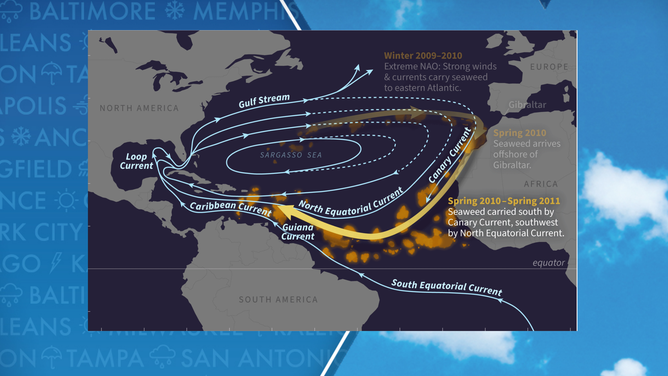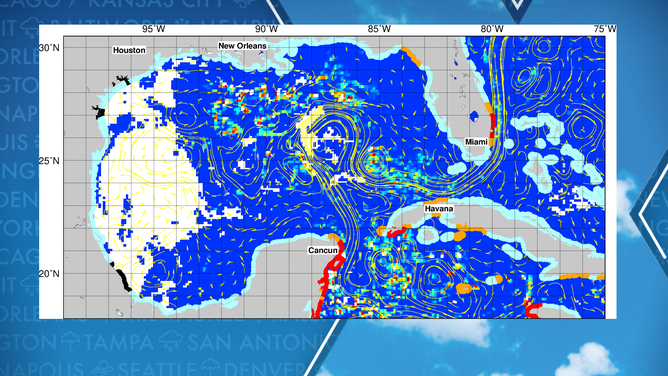Historical sargassum seaweed events could provide clues on current lobs impacting Gulf Coast, Caribbean
The University of South Florida says the 13-million-ton conglomeration of sargassum seaweed floating across the Atlantic Ocean set a record earlier in 2023.
How massive Florida seaweed is impacting sea turtles during nesting season
The sea turtles are putting conservation teams to work. It’s just over two months into sea turtle nesting season for Florida and teams along the coasts are surveying the beaches every morning for them. FOX Weather’s Brandy Campbell took us along for a survey in Fort Lauderdale, Florida.
TAMPA, Fla. – Experts have warned for months that Florida and other parts of the Gulf Coast and Caribbean could be impacted by a record-breaking amount of sargassum seaweed, but its origin has been difficult to pin down. Some experts have attributed the seaweed to polluted runoff from South America, while others have said it is impossible to determine the cause because of how much is unknown about this natural process.
When massive mounds of seaweed piled up on beaches throughout the Caribbean and Africa in the summer of 2011, NOAA researchers embarked on a project to find the source and believe they have stumbled upon a hypothesis that could explain the event’s region of origin.
According to a study published in the journal Environmental Science, researchers found evidence that a complex interaction of oceanic and atmospheric factors in the North Atlantic region could have triggered the proliferation of the sargassum.
The 2010-11 winter was extreme for North America and Europe, with heavy snow and colder-than-average temperatures. Experts believe the weather pattern triggered westerly winds through the Sargasso Sea, a region in the Atlantic Ocean, for an extended period, sending the stinky seaweed farther east.
HOW MASSIVE FLORIDA SEAWEED IS IMPACTING SEA TURTLES DURING NESTING SEASON

How seaweed from the Sargasso Sea could have spread to the tropical Atlantic and Caribbean
(NOAA)
Dr. Chuanmin Hu, a marine science professor at the University of South Florida, was a co-author of the study and stressed the research could serve as a starting point for future analysis, but there is still a lot unknown about sargassum.
"It’s a plausible hypothesis, but that’s all we can say," Hu said. "No one has really proved the theory. We actually don’t know where it started or where it ended. We only know there’s a seasonal cycle. There’s a winter lull and the summer high. What we know is the 2011 event was a tipping point. Before 2011, there was almost nothing in the tropical Atlantic, but after then, almost every year, we have this sargassum belt."
Hu said the accuracy surrounding the timeline of an invasion of seaweed is more straightforward for scientists to determine than its origins because satellite observations and witness accounts play a significant role in determining the start and finish points.
FLORIDA KEYS CAUTIOUSLY WATCH VISITOR SENTIMENT FOR IMPACTS OF INCOMING SEAWEED
2023 sargassum belt continues to plague beaches into summer
For the seaweed event that is currently underway, the USF professor believes that Sunshine State is in the middle of impacts and will likely start to transition out of it later in the summer.
"This is easier to tell than understanding where it came from," Hu said. "For Florida, there is about a month lag from the Caribbean. So, whatever could impact Florida, comes from the Caribbean Sea in about a month or two. Not all the seaweed that impacts the Caribbean impacts Florida, but some does."
Coastal communities along the Yucatan Peninsula, western Cuba and some isolated spots along the Florida Peninsula have been impacted by large amounts of seaweed that, according to local health departments, is not harmful to humans.
Experts said future studies of the origins of the seaweed could help in determining the cycle of the sargassum, but Hu said he believes there is a long way to go before there is a solid understanding and determining what preventive actions could be most impactful in reducing the stinky mess.

Sargassum Inundation Report for May 2 - 8, 2023. Coastal risk levels: Low (Blue), Medium (Orange), High (Red), No data (Gray)
(NOAA)
